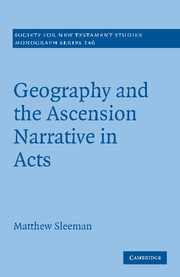1 - Ascension scholarship at the turn of the century
Published online by Cambridge University Press: 13 February 2010
Summary
Half a century ago, writing about the Lukan ascension accounts, P. A. van Stempvoort declared that ‘discussion never ends’. He continued: ‘The flood of publications goes on from year to year. Only new points of view give one boldness to add another.’ This study adds a new point of view to our understanding of Jesus' ascension by examining its impact on the narrative production of space within Acts.
Part I (Chapters 1 and 2) unpacks the theory underpinning this aim, and then Part II (Chapters 3–7) applies the theory in a ‘spatialised’ reading of Acts 1:1–11:18. As such, this study links three poles of scholarly inquiry, namely Christ's ascension, narrative-critical readings of Acts, and the role of geography in constructing and communicating that narrative's theological message. As the opening two chapters argue, previous scholarship has failed to integrate these three considerations and each has been impoverished as a result. Instead, the ascension requires a narrative positioning within Acts, and Acts as narrative requires a heavenward orientation. Both these claims require a proper understanding of the ways in which Jesus' ascension restructures earthly places and space within the narrative.
This opening chapter positions the direction for this study within existing scholarship concerning the ascension in Acts. This task is greatly helped by Arie Zwiep's monograph on the ascension in Luke and Acts.
- Type
- Chapter
- Information
- Geography and the Ascension Narrative in Acts , pp. 3 - 21Publisher: Cambridge University PressPrint publication year: 2009



